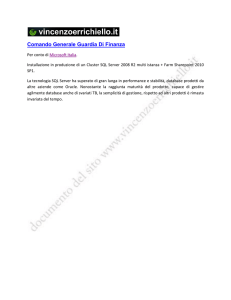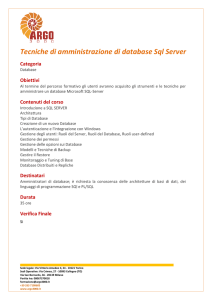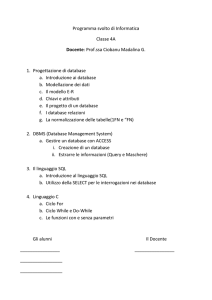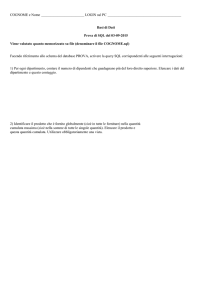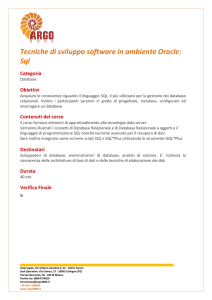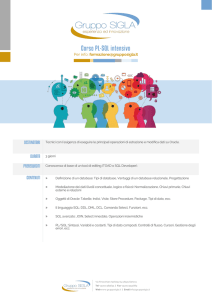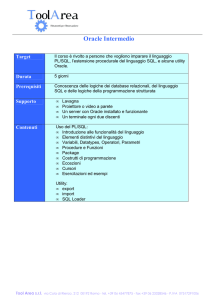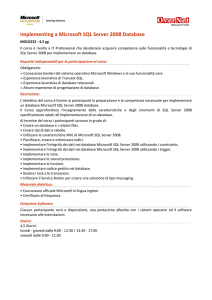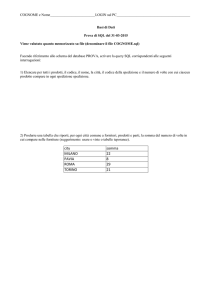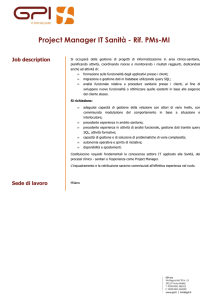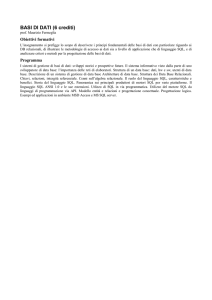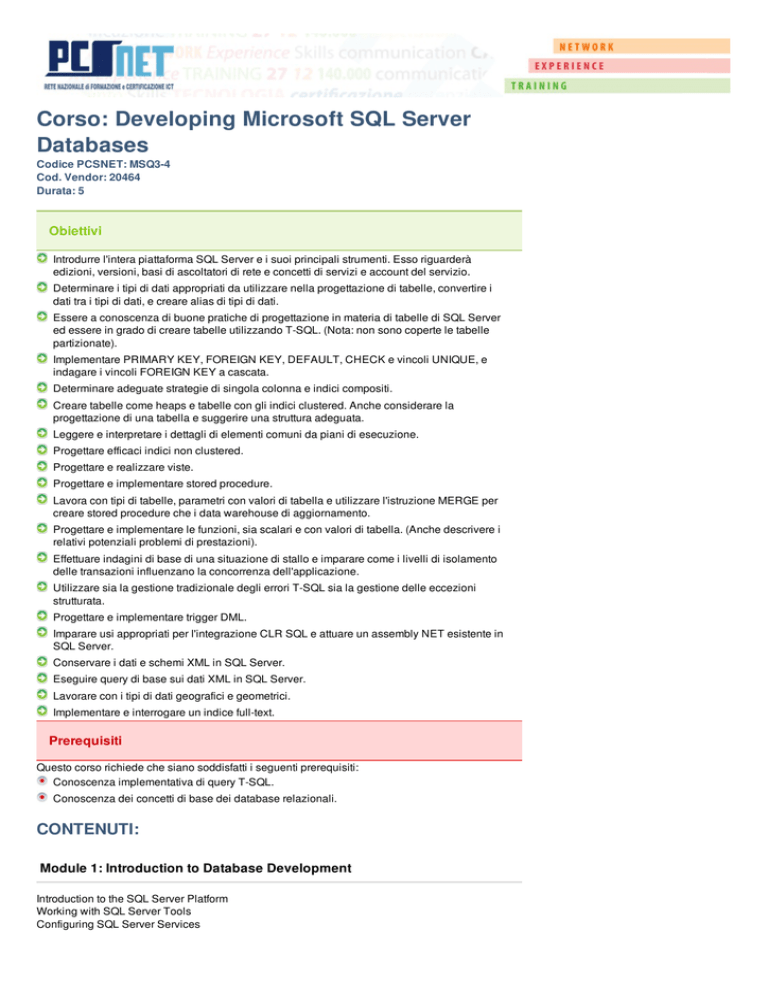
Corso: Developing Microsoft SQL Server
Databases
Codice PCSNET: MSQ3-4
Cod. Vendor: 20464
Durata: 5
Obiettivi
Introdurre l'intera piattaforma SQL Server e i suoi principali strumenti. Esso riguarderà
edizioni, versioni, basi di ascoltatori di rete e concetti di servizi e account del servizio.
Determinare i tipi di dati appropriati da utilizzare nella progettazione di tabelle, convertire i
dati tra i tipi di dati, e creare alias di tipi di dati.
Essere a conoscenza di buone pratiche di progettazione in materia di tabelle di SQL Server
ed essere in grado di creare tabelle utilizzando T-SQL. (Nota: non sono coperte le tabelle
partizionate).
Implementare PRIMARY KEY, FOREIGN KEY, DEFAULT, CHECK e vincoli UNIQUE, e
indagare i vincoli FOREIGN KEY a cascata.
Determinare adeguate strategie di singola colonna e indici compositi.
Creare tabelle come heaps e tabelle con gli indici clustered. Anche considerare la
progettazione di una tabella e suggerire una struttura adeguata.
Leggere e interpretare i dettagli di elementi comuni da piani di esecuzione.
Progettare efficaci indici non clustered.
Progettare e realizzare viste.
Progettare e implementare stored procedure.
Lavora con tipi di tabelle, parametri con valori di tabella e utilizzare l'istruzione MERGE per
creare stored procedure che i data warehouse di aggiornamento.
Progettare e implementare le funzioni, sia scalari e con valori di tabella. (Anche descrivere i
relativi potenziali problemi di prestazioni).
Effettuare indagini di base di una situazione di stallo e imparare come i livelli di isolamento
delle transazioni influenzano la concorrenza dell'applicazione.
Utilizzare sia la gestione tradizionale degli errori T-SQL sia la gestione delle eccezioni
strutturata.
Progettare e implementare trigger DML.
Imparare usi appropriati per l'integrazione CLR SQL e attuare un assembly NET esistente in
SQL Server.
Conservare i dati e schemi XML in SQL Server.
Eseguire query di base sui dati XML in SQL Server.
Lavorare con i tipi di dati geografici e geometrici.
Implementare e interrogare un indice full-text.
Prerequisiti
Questo corso richiede che siano soddisfatti i seguenti prerequisiti:
Conoscenza implementativa di query T-SQL.
Conoscenza dei concetti di base dei database relazionali.
CONTENUTI:
Module 1: Introduction to Database Development
Introduction to the SQL Server Platform
Working with SQL Server Tools
Configuring SQL Server Services
Lab : Introduction to Database Development
Start SQL Server Management Studio
Module 2: Designing and Implementing Tables
Designing Tables
Working with Schemas
Creating and Altering Tables
Lab : Designing and Implementing Tables
Improving the Design of Tables
Creating a Schema
Creating the Tables
Module 3: Ensuring Data Integrity through Constraints
Enforcing Data Integrity
Implementing Domain Integrity
Implementing Entity and Referential Integrity
Lab : Ensuring Data Integrity through Constraints
Designing Constraints
Testing the constraints
Module 4: Introduction to Indexing
Core Indexing Concepts
Single Column and Composite Indexes
SQL Server Table Structures
Working with Clustered Indexes
Lab : Creating Indexes
Creating Tables with Clustered Indexes
Improving Performance through Nonclustered Indexes
Module 5: Advanced Indexing
Execution Plan Core Concepts
Common Execution Plan Elements
Working with Execution Plans
Designing Effective Nonclustered Indexes
Performance Monitoring
Lab : Planning for SQL Server 2014 Indexing
Exploring Existing Index Statistics
Creating Covering Indexes
Module 6: Columnstore Indexes
Columnstore Indexes
Best Practices for Columnstore Indexes
Lab : Using In-Memory Database Capabilities
Creating Columnstore Indexes
Module 7: Designing and Implementing Views
Introduction to Views
Creating and Managing Views
Performance Considerations for Views
Lab : Designing and Implementing Views
Designing, Implementing and Testing the WebStock Views
Designing and Implementing the Contacts View
Modifying the AvailableModels View
Module 8: Designing and Implementing Stored Procedures
Introduction to Stored Procedures
Working With Stored Procedures
Implementing Parameterized Stored Procedures
Controlling Execution Context
Lab : Designing and Implementing Stored Procedures
Creating stored procedures
Creating a parameterized stored procedure
Altering the execution context of stored procedures
Module 9: Designing and Implementing User-Defined Functions
Overview of Functions
Designing and Implementing Scalar Functions
Designing and Implementing Table-Valued Functions
Implementation Considerations for Functions
Alternatives to Functions
Lab : Designing and Implementing User-Defined Functions
Formatting Phone Numbers
Modifying an Existing Function
Resolving a Function-Related Performance Issue
Module 10: Responding to Data Manipulation via Triggers
Designing DML Triggers
Implementing DML Triggers
Advanced Trigger Concepts
Lab : Responding to Data Manipulation via Triggers
Creating and Testing the Audit Trigger
Improving the Audit Trigger
Module 11: Using In-Memory Tables
Memory-Optimized Tables
Native Stored Procedures
Lab : Using In-Memory Database Capabilities
Working with Memory Optimized Tables
Working with Natively Compiled Stored Procedures
Module 12: Implementing Managed Code in SQL Server
Introduction to SQL CLR Integration
Importing and Configuring Assemblies
Implementing SQL CLR Integration
Lab : Implementing Managed Code in SQL Server
Assessing Proposed CLR Code
Implementing a CLR Assembly
Implementing a CLR User-defined Aggregate and CLR User-defined Data Type
Module 13: Storing and Querying XML Data in SQL Server
Introduction to XML and XML Schemas
Storing XML Data and Schemas in SQL Server
Implementing the XML Data Type
Using the T-SQL FOR XML Statement
Getting Started with XQuery
Shredding XML
Lab : Storing and Querying XML Data in SQL Server
Assessing appropriate Use of XML Data in SQL Server
Testing XML Data Storage in Variables
Retrieving Information about XML Schema Collections
Querying SQL Server Data as XML
Write a Stored Procedure Returning XML
Module 14: Working with SQL Server Spatial Data
Introduction to Spatial Data
Working with SQL Server Spatial Data Types
Using Spatial Data in Applications
Lab : Working with SQL Server Spatial Data
Querying the Geometry Data Type
Adding Spatial Data to an Existing Table

